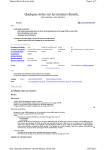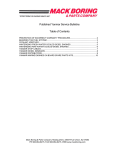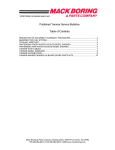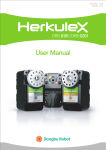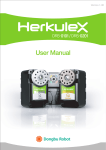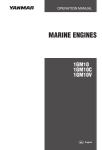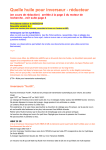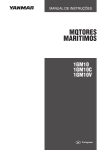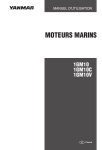Download Yanmar 3GM30F Specifications
Transcript
Maintenance of Pleasureboat Diesel Engine GM Series 1.Safety Precaution for Inspection 1) Battery Fluid Battery fluid is diluted sulfuric acid. It can blind you if it gets in your eyes, or burn your skin. Keep the fluid away from your body. Wash it off immediately with a large quantity of fresh water if you get any on you. 2) Fire due to Electric Short-Circuits Always turn off the battery switch or detach the earth cable(-) before inspecting the electrical system. Failure to do so could cause short-circuiting and fires. 3) Precautions for Moving Parts Stop the engine before you service it. If you must inspect while the engine is operating, never touch moving parts. Keep your body and clothing well clear of all moving parts as this could result in injury. 4) Precautions for Removing Hot Oil and Water to Prevent Burns If extracting oil from the engine while it is still hot, do not let the oil splash on you. Wait until the temperature has dropped before removing cooling water from the engine to avoid getting scalded. 5) Burns from Contact with Hot Engine Parts The whole engine is hot during operation and immediately after stopping. The turbocharger, exhaust manifold, exhaust pipe, and engine are very hot. Never touch these parts with your body or clothing. 6) Burns from Scalding Never remove the filler cap of the fresh water cooler while the engine is still hot. Stream and hot water will spurt out and seriously burn you. Wait until the water temperature has dropped, then wrap a cloth around the cap and loosen it slowly. After inspection, refasten the filler cap firmly. If the cap is not secure, steam or scalding water may be emitted during operation causing burns. 2.Engine Specifications Type Engine Model Number of cylinders Cont. rating output Max. output Lube oil capacity Vertical water-cooled 4-cycle diesel engine 1GM10 2GM20(F) 3GM30(F) 1 2 3 5.9kW(8PS)/3400min- 11.8kW(16PS)/3400min- 17.7kW(24PS)/3400min1 1 1 6.6kW(9PS)/3600min- 13.2kW(18PS)/3600min- 19.9kW(27PS)/3600min1 1 1 Engine L oil Clutch oil L 3.Fuel oil, lube oil and cooling water 3.1 fuel oil 1.3L 2.0L 2.7L 0.25L 0.25L 0.3L 1) 1) Selection of fuel oil Use the following diesel fuels or equivalents. Select fuels of a higher quality for best engine performance. [Diesel fuel standard for various countries] ISO 8217 DMA ASTM D975 Grade No.1-D or No.2-D JIS K2204 Grade No.2, No.3 or special-No.3 BS 2869 Part-1 class-A1 or A2 At low temperatures, fuel oil becomes difficult to ignite and will not flow easily, making starting difficult. Select fuel oil of a cetane of 45 or greater to insure ignitability, and use the outside temperature as a guide for selecting the proper grade to insure fluidity. 2) Handling of Fuel Oil Keep the fuel oil in a clean container. Store the container in a place away from rain and dirt as water and dust mixed in with the fuel cause engine failure. Keep the fuel container stationery for several hours to allow any dirt or water to settle to the bottom. Use a pump to extract the clear, filtered fuel from the top of the container for use. 3.2 Lube oil 1) Selection of Engine oil Use the following lube oil API Classification• • CD SAE Viscosity • • 15W40 2) 2) Selection of Marine gear lube oil API Classification • • CD SAE Viscosity • • #30 3) Handling the Lube Oil When handling and storing lube oil, be careful not to allow dust and water to enter the lube oil. Clean around the filler port before refilling. Do not mix. lube oils of different types or brands. Mixing may reduce the lubricating performance. Different oils are used for the engine and the marine gear. Be careful to use the correct oil for each one and store in separate clearly labeled containers 3.3 Cooling water (Fresh water cooling type) 1) Always use soft water (tap water) for the fresh water. Never use dirty water or hard water. Impurities in the cooling water cause scale and rust to build up in the cooling system reduction cooling efficiency and causing the engine to overheat. 2) During the cold season, add antifreeze to the cooling water to prevent freezing. Failure to add antifreeze will result in damage to various parts in the cooling water system. 3) Refer to the instruction accompanying the antifreeze for the proper mixing ratio. Select the ratio for the lowest temperature of the cold season. If the mixture is too thick, the cooling efficiency will be reduced. 4) Do not mix different brands of antifreeze or anti-rust. Mixing reduces cooling efficiency and leads to parts damage. 5) When the amount of cooling water is too low, refill with fresh water only. 4.Maintenance and Inspection 4.1 Fuel Oil System 4.1.1 4.1.1 Checking and Supplying Fuel Oil Check the fuel level inside the fuel tank and supply with the recommended fuel if necessary. Inspection • • daily (before starting) 4.1.2 Draining the fuel tank 1. Put a pan under the drain to catch the fuel. 2. Loosen the drain cock at the bottom of the fuel tank, and drain off any water and dirt collected inside. 3. Once the water and dirt have been drained off and the fuel coming out is clear, close the drain plug. Inspection • • every 50hrs. 4.1.3 Replacing the fuel filter 1. Close the fuel cook. 2. Turn the element casing fixing screw to the left with the filter wrench and remove. 3. Clean the filter casing. 4. Turn the element casing fixing screw to the right, use the filter wrench to tighten. 5. Be sure be bleed air out of the fuel system. 4.2 Lube Oil System 4.2.1 Checking and Supplying Engine oil 1. Check the engine oil level with the oil dipstick. 2. If the oil level is low, supply with the recommended lube oil using the filler port. Supply oil up to the upper mark on the oil dipstick. Inspection • • daily (before start-up) 4.2.2 Check and supply of Marine gear oil 1. Check the marine gear oil level with the oil dipstick. 2. Supply with the recommended oil if necessary. Check the oil level with the dipstick while to the upper mark. Inspection • • daily (before starting) 4.2.3 Replacing the Engine Lube Oil and Lube Oil Filters 1. Drain off the lube oil. It is easier and more effective to drain the engine lube oil while the engine is still warm after operation. 1) After removing the oil dipstick, attach the hose of the oil drain pump to the dipstick guide hole. 2) Drain off the oil with the drain pump. 2. Replace the lube oil filter 1) Turn the lube oil filter to the left with the filter wrench and remove. 2) Clean the filter installation face. 3) Apply engine oil to the installation face and put on the new filter, turning it to the right by hand. Next, tighten an additional 3/4 of a turn with the filter wrench. 3. Fill with new lube oil. 1) Fill with the specified amount of engine oil. Remove the oil inlet cap on the top of the bonnet and fill with oil. Remove the oil dipstick and check the level of the oil with the gauge on the stick. Oil should be filled to the upper mark on the dipstick gauge Replace the dipstick and tighten the oil inlet cap firmly by hand. 2• Run the engine for approximately 5 minutes and check to see if there is any oil leakage 3) Approximately 10 minutes after stopping, check the oil level again with the oil dipstick and more oil if necessary. Replace first • • • after initial 50 hours Second time and thereafter • • every 250 hours( 1 year) 4.2.4 Replacing the Marine Gear Lube Oil Replace the lube oil in the marine gear by using the procedure described above. Replace first • • after initial 50 hours second time • • every 250 hours thereafter • • every 1000 hours 4.3 Cooling Water System 4.3.1 Check and supply of cooling water 1. Check the cooling water level in the sub-tank. If the water level is close to the lower limit, remove the sub tank cap and fill with fresh water to the upper limit. 2. When the water level in the sub-tank is low, remove the filler cap for the fresh water tank and check the amount of cooling water in the fresh water tank. Fill with fresh water to overflowing if the level is low. Check the fresh water level before operation while the engine is cold. Checking the water level while the engine is hot is dangerous, and the cooling water reading will be misleading due to thermal expansion. Check and supply cooling water daily at the sub-tank. Do not remove the fresh water cooler f1iller cap regularly. The amount of water in the sub tank will increase during operation. This is normal. When the engine is stopped, the temperature of the cooling water will drop causing the extra water in the sub tank to return to the fresh water tank. Inspection • • daily (before starting) 4.3.2 Checking discharged from the seawater outlet pipe Check that sufficient cooling water is discharged from the seawater outlet pipe. Operation with too little seawater discharge will burn the impeller of the seawater pump. If seawater discharge is too small, stop the engine immediately, identify the cause and repair. Is the Kingston cock open Is the inlet of the Kingston cock clogged Is the sea water suction hose broken, or does the hose suck in air due to a loose joint 4.3.3 Inspecting Inner Parts of the Seawater Pump The inside parts of the seawater pump will deteriorate with use, and discharge performance falls. At the specified interval or when the volume of seawater discharged is reduced, inspect the seawater pump in accordance with the following procedures. 1. Loosen the side cover set bolt and remove the side cover. 2. Illuminate the inside of the seawater pump with a flashlight and inspect. If any of the following problems is found, disassembly and maintenance are necessary. Impeller blades are cracked or nicked. Edges or surfaces of the blades are marred or worm. The impeller must be replaced periodically every 2000 hrs. Wear plate is damaged. 3. If no damage is found when inspecting the inside of the pump, replace the side cover. Fit the O-ring to the groove of the joint face before replacing the side cover. If a large amount of water leaks continuously from the seawater pump during operation, disassembly and maintenance ( replacement of the mechanical seal ) are necessary. When disassembly and maintenance of the seawater pump are necessary, consult your Yanmar dealer or distributor. Inspection • • every 1000 hours. Replace • • every 2000 hours. 4.3.4 Inspection and Replace Anti-corrosive zinc (seawater cooling line) 1. 2. 3. 4. Close the Kingston cock. Drain the cooling seawater. Remove the plug labeled ZINC and indicated in the diagram. Check the zinc on the inside of the plug to determine the amount of wear to the anti-corrosive zinc. Replace the anti-corrosive zinc when it has been reduced to less than 1/2 of its original size. If there is only a little bit of wear, clean the surface by sanding off any corroded areas. 5. Replace plug. 6. Open the Kingston cock and check water leakage. Inspection • • every 500 hours. 4.4 Inspection of the Electrical Parts 4.4.1 Inspection of Battery Check the level of fluid in the battery. When the amount of fluid nears the lower limit, fill with battery fluid (available in the market) to the upper limit. If operation continues with insufficient battery fluid, the battery life is shortened, and the battery may overheat and explode. Battery fluid tends to evaporate more quickly in the summer, and the fluid level should be checked earlier than the specified times. If the engine turns over at a slower than usual rate and refuses to start, recharge the battery. If the engine still will not start after charging, replace the battery. Inspection • • daily (before start-up) 4.4.2 Checking the Tension of the V-Belt of the Alternator When there is not enough tension in the V-belt, the belt will slip making it impossible for the alternator to generate power. Additionally, the fresh water pump will not work causing the engine to overheat. Check the tension of the V-belt in the following manner. 1. Press the V-belt down with your thumb at the middle of the belt to check the tension. The give in the V-belt should measure about 8 • 10mm at the depression. 2. To adjust the V-belt tension, loosen the set bolt and move the alternator. 3. Replace the belt if it is damaged. Inspection • • every 500 hours Replace • • every 2000 hours 4.4.3 Adjusting the Remote Control Handle The remote control handles and the engine control levers are connected by an accelerator cable. Over time the cable becomes stretched and the connections loose causing deviation in the position, which makes operation unsafe. Inspect the cable periodically and adjust if necessary. 1. Adjusting the Governor Remote Control Handle Check to see that the speed lever on the engine side is touching the high speed limiting bolt when the governor handle is put in H ( High Speed ). Check to see that the speed lever on the engine side is touching the low speed limiting bolt when the governor handle is put in L ( Low Speed ). If the speed lever does not touch the limiting bolt for either the high or low speed, when you check them, loosen the setting screws on the fittings for the accelerator cable and adjust the position of the cable. 2. Adjusting the Clutch Remote Control Handle for the Marine Gear Check to see that the clutch lever on the engine side is in the neutral position when the remote control handle is in NEUTRAL. If the position of the clutch lever is incorrect, loosen the setting screw of the cable. Check the clutch lever in ! FWD ( Forward ) " REV ( Reverse ) making sure it is correctly aligned. Make any necessary adjustments using NEWTRAL as the central point. Inspection • • every 250 hours 5. Principal specifications 5.1 Specifications Engine Model Idling speed High idling speed 1GM10 min-1 min-1 2GM20(F) 850±25 3825±25 3GM30(F) Firing order Suction Exhaust Injection timing (FID) Injection pressure Lubricant pressure Valve clearance - • • • • Mpa Mpa 5.2 List of tightening torques Engine Model Cylinder head Injection nozzle Connecting rod 1-2-1 1-3-4-2-1 0.2±0.03 0.2±0.03 bTDC 15°±1 bTDC 15°±1 bTDC 18°±1 19.6±0.49 (200±5kg/cm2) 0.39±0.05 (4.0±0.5kg/cm2) 1GM10 2GM20(F) 3GM30(F) Main nut and bolts 117.7(12.0 kgf-m) 73.5 N-m (7.5 kgf-m) Auxiliary bolts 29.4(3.0 kgf-m) N-m 19.6(2.0 kgf-m) N-m 24.5(2.5 kgf-m) 6. Trouble and troubleshooting If you should encounter some difficulty during operation, refer to the following table for countermeasures. Trouble Probable Cause Measure Problem occurs during operation. NOTICE When the alarm equipment indicates a problem, immediately put the clutch in neutral and run the engine at low speed. Check to see which alarm indicator is lit, then stop the engine and inspect. When you cannot determine the source of the problem, return to port at low speed and ask your Yanmar dealer for repair. Alarm buzzer sounds and alarm come on. Faulty battery Check battery fluid. Adjust V-belt tension or replace V-belt is loose or damaged belt. Charge Lamp Alternator is not generating Ask for repairs. electricity (Alarm buzzer does not sound) Insufficient cooling water in fresh water tank Leakage in fresh water cooling system Fresh water cooling pump is damaged C.W. Temp. Lamp goes on Inside of C.W. system is dirty L.O. Press. Alarm Lamp goes on Insufficient engine oil Insufficient discharge of cooling seawater Check and replenish cooling water. Ask for repairs for water leakage. Ask for repairs. Ask for repairs. Replenish engine oil. Kingston cock is closed. Kingston cock is clogged. Suction hose is damaged or joints loose. Exhaust Alarm Lamp goes on Faulty Alarm Device Damaged cooling seawater pump Check seawater pump impeller. NOTICE Do not operate the engine if alarm devices are not working properly. Serious accidents may result if difficulties are not spotted due to faulty alarm lamps. Before starting when switch is turned from OFF ! ON, alarm devices do not work. Circuit broken or buzzer Alarm buzzer does not sound. Ask for repairs. damaged. Some alarm lamps do not light up. Circuit broken or lamp burnt out. Ask for repairs. After starting when switch returns from START ! ON, alarm devices do not work. Alarm buzzer does not cut off. Short circuit Ask for repairs. Some alarm lamps do not go out. Damaged sensor or switch Ask for repairs. Starting Failures No fuel Replenish fuel: bleed. Air in fuel line Bleed. Bad fuel Replace with recommended fuel. Clogged fuel filter Replace fuel filter. Poor fuel injection Ask for repairs. Pressure leakage from Starter does not turn. Ask for repairs. intake/exhaust valves Insufficient battery charge Check battery fluid, recharge. Remote rust from terminal; Faulty cable connection at terminal retighten Faulty starter switch Ask for repairs. Starter does not turn or turns too solely Faulty starter Ask for repairs. (can be turned by hand) Cannot be turned manually Poor exhaust color Overload Insufficient fuel Faulty spraying of F.O. injection Black smoke emitted. Inner parts seized or damaged Ask for repairs. Reduce load. Replace with recommended fuel. Ask for repairs. Excessive intake/exhaust valve top clearance Ask for repairs. Insufficient fuel Replace with recommended fuel. Faulty spraying of F.O. injection Fuel injection timing off Ask for repairs. Ask for repairs. White smoke emitted. Lube oil burns/excessive consumption Ask for repairs.










